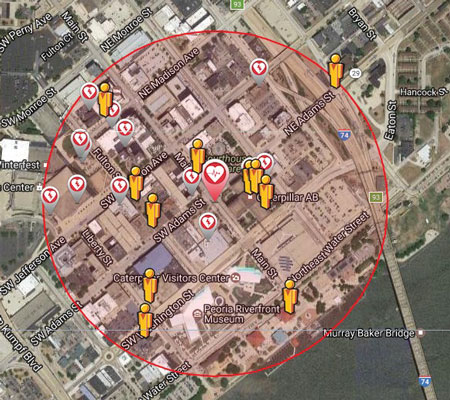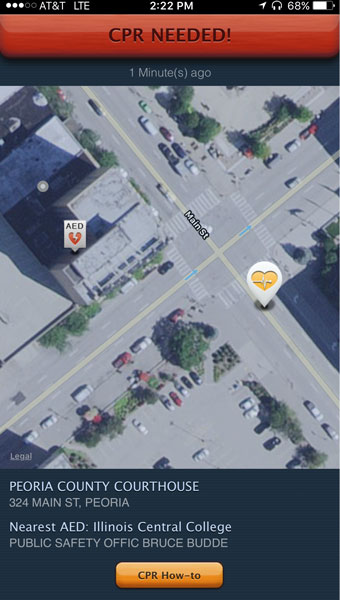Victims of sudden cardiac arrest are more likely to survive due to a multi-faceted, nationally recognized strategy.
In May 2015, Advanced Medical Transport (AMT) launched a strategic initiative to dramatically increase the number of patients who survive sudden cardiac arrest (SCA). In 2016, the Race to the Top program saved 21 lives, with a survival rate of 45 percent—almost double the national average.
Last November, the American Ambulance Association (AAA) recognized AMT’s Race to the Top program with the nationally acclaimed AMBY award for Best Clinical Outcomes Project, which recognizes innovative practices in the ambulance industry. Of course, AMT does not intend to stop there. By increasing community awareness, educating citizen responders and assuring our providers are delivering today’s best medical care, AMT strives to push the SCA survival rate in central Illinois even higher.
What is Sudden Cardiac Arrest?
Sudden cardiac arrest is the leading cause of death in adults over the age of 40. An SCA occurs when a victim’s heart stops beating or beats abnormally, which means that no blood is circulating to vital organs, including the brain. If circulation is not restored or manually applied using CPR within five minutes, the likelihood of the victim surviving is very low. For every minute that passes without CPR, the chance of survival declines by 10 percent.
More than 325,000 Americans suffer an SCA each year, with a national survival rate of less than 10 percent… dismal statistics indeed. AMT realized that a more effective and comprehensive intervention strategy required more community involvement and the leadership to initiate a change.
 To Win the Battle
To Win the Battle
AMT developed the “Race to the Top” strategy in conjunction with physician experts in emergency medicine, our community’s medical centers and biomedical device manufacturers. The program’s eight focus areas are as follows:
- Immediate recognition of sudden cardiac arrest;
- 911 activation, “first-care” hands-only CPR, GPS to the rescue;
- Community access to and utilization of AEDs;
- Pit crew resuscitation by EMS providers;
- Deployment of Advanced Practice Paramedics;
- Advanced biomedical tools;
- Immediate provider feedback; and
- Community and caregiver recognition.
The program relies on community involvement, state-of-the-art training and technology, and constant process review to achieve the best clinical outcomes possible.
The Civilian First Responder
Bystanders and community members have the most significant role in the survival of an SCA. Performing hands-only CPR on an SCA victim until paramedics arrive adds precious minutes to the survival window. The first five minutes of a SCA are the most critical; after this window, the chances of surviving an SCA are very poor. Research shows that only 12 percent of SCA victims receive CPR before the paramedics arrive—a percentage that can be easily increased.
Due to the importance of civilian responders, AMT has adopted a community outreach strategy that supports CPR and AED education. Current resuscitation science emphasizes the importance of immediate compression-only—also known as hands-only—CPR. With more people in our community trained in compression-only CPR, SCA patients can start receiving lifesaving treatment sooner. The average age of an SCA patient in the Peoria area is 64, with 70 percent of sudden cardiac arrests occurring in the home. By learning hands-only CPR in the community, you can save the life of your loved one at home.
 PulsePoint: Enabling Citizen Superheroes
PulsePoint: Enabling Citizen Superheroes
In June 2016, AMT introduced the “PulsePoint” mobile application. Available on Apple iOS and Android, PulsePoint sends an alert to individuals trained in CPR in the immediate vicinity of an SCA that occurs in a public location. This alert allows trained citizens to respond to an SCA immediately and provide care until paramedics arrive. PulsePoint also notifies citizen responders where the closest public access defibrillator (AED) is located.
As part of its community outreach strategy, AMT has donated more than 690 AEDs for public access throughout the community since 2001. Research has shown that in combination with high-quality CPR, AED usage improves the chances of surviving sudden cardiac arrest by 30 percent. The PulsePoint AED application also allows community members to add any public access defibrillator to the AED registry by simply uploading a photo and location of the device.
Technology to Realize Process Improvement
In addition to the PulsePoint mobile application, AMT uses state-of-the-art cardiac monitoring systems. Devices such as the Zoll X Series cardiac monitor allow AMT caregivers to conduct a thorough post-call event review. Used exclusively by AMT, these biomedical devices record multiple streams of data, which prove invaluable in expanding the quality of care provided to SCA victims.
 Data gathered by high-tech devices such as the Zoll X Series is then submitted to the CARES National Registry, a CDC-approved database used for cardiac arrest process improvement. Utilizing this registry, AMT can compare central Illinois’ SCA outcomes with peer cities throughout North America to refine and establish best clinical care practices and influence improved patient outcomes.
Data gathered by high-tech devices such as the Zoll X Series is then submitted to the CARES National Registry, a CDC-approved database used for cardiac arrest process improvement. Utilizing this registry, AMT can compare central Illinois’ SCA outcomes with peer cities throughout North America to refine and establish best clinical care practices and influence improved patient outcomes.
Putting It All Together
National recognition of AMT’s evidence-based Race to the Top initiative, with promising results represented by actual lives saved, is just the beginning. The AMBY award recognizes excellence in the program, but there is much more to be accomplished.
AMT is proud to announce its newest collaboration and partnership with Take Heart America, a leading national organization that brings together experts from all disciplines of sudden cardiac arrest science. The collaboration joins AMT’s dedication to improving the survival rate for victims of sudden cardiac arrest with the work of a leading national cardiac research organization.
In just 18 months, the rate of bystander CPR in the Peoria area increased from 13 to 33 percent, while the survival-to-discharge rate for SCA victims almost doubled. Imagine what could be achieved if CPR was provided to all victims of sudden cardiac arrest by bystanders delivering quality, compression-only CPR. There is ample evidence to suggest that lives saved could be doubled again!
The best measure of Race to the Top is not awards received, but lives saved and patients who are able to celebrate their next birthday. Increasing citizen engagement in the battle against sudden cardiac arrest is an essential component of this community health initiative. iBi
To learn more about AMT’s Race to the Top strategy or to obtain information on free, hands-only CPR training, contact Josh Bradshaw at [email protected].


